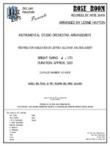CONCERTO FOR CLARINET [DOWNLOAD]
Recorded by Artie Shaw
Arranged by Lennie Hayton, Prepared by Dylan Canterbury, Rob DuBoff, and Jeffrey Sultanof

Cat #: JLP-8802-DL
$85.00This product is available for immediate download after purchase.
Questions?
Please call +1-518-587-1102 or email us.
Edition: Jazz Studio Orchestra Arrangement
Description: Swing - Advanced (clarinet soloist); Medium Difficult (ensemble)
Publisher: Jazz Lines Publications
Although not your typical example of the concerto form, Artie Shaw's 'Concerto for Clarinet' does still take cues from its classical namesake's structure. The piece is broken down into three "movements," all based around the classic 12 bar blues form, with some brief interlude material between each. Notably, it was performed in the 1940 Fred Astaire film 'Second Chorus.'
The first movement kicks off with a rapidly paced ascending ensemble figure before the bottom falls out for Shaw's entrance at measure 5. The following 10 measures are highly rubato; Shaw only hints at the written melody, and largely improvises over a bed of lush strings. The tempo finally kicks in at measure 15 for the full ensemble's re-appearance. A standard bluesy lick in the trumpets rides atop some gentle accompaniment from the saxes and trombones, all while the rhythm section pushes along underneath.
The second movement starts out with a rumbling boogie-woogie style piano solo with only the drums accompanying. This solo lasts for two blues choruses before the guitar and drums join back in for Shaw's three choruses of improvised clarinet The saxes join in with some simple backgrounds on the second chorus. The band proceeds to open things up to showcase some other instrumentalists - two choruses of alto sax, one chorus of trombone, one chorus of tenor sax, and two choruses of trumpet. The backgrounds behind each solo range from simple string pads to more intricate call-and-response riffs between the trombones and saxes. Shaw finally re-emerges for one last chorus at measure 98 before another transitional section of some brief cadenzas over the ensemble.
Perhaps taking a cue from his perennial rival Benny Goodman, the third movement begins with an improvised clarinet solo over a hard-driving tom-tom groove. There are two of these ad-lib sections, separated by some intricately written-out clarinet lines and stabbing ensemble hits. Some string pads and four final measures of clarinet solo return things to a more traditional blues feel at measure 138. Here, the saxes play a simple melodic riff that receives an equally simple response riff from the brass. The trumpets eventually switch over to fanning their derbies at measure 150, where Shaw returns once again to solo over the top of everything. The ensemble continues to whip up into a frenzy all the way to a fake-out ending at measure 172. Shaw plays a few more brief cadenzas over the ensemble, eventually being left to his own devices, where he builds up to a climactic altissimo C before the band returns to bring everything crashing back down.
This publication has been prepared using the original 1940 parts - this is not a transcription.
Clarinet Soloist
2 Alto Saxophones
2 Tenor Saxophones
Baritone Saxophone (Optional)
3 Trumpets
3 Trombones
3 Violins
Viola
Cello
Guitar
Piano
Bass
Drums
Trombone 1: C5







